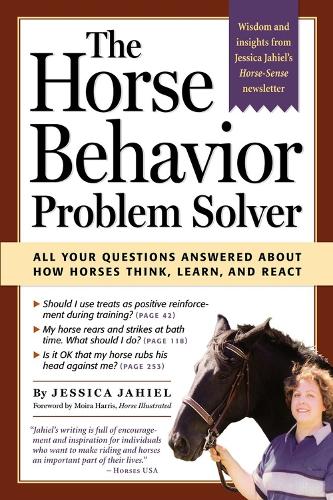
The Horse Behavior Problem Solver: All Your Questions Answered About How Horses Think, Learn, and React
(Paperback)
Publishing Details
The Horse Behavior Problem Solver: All Your Questions Answered About How Horses Think, Learn, and React
By (Author) Jessica Jahiel
Workman Publishing
Storey Publishing LLC
1st April 2004
United States
Classifications
General
Non Fiction
Riding, showjumping and horsemanship
636.1
Physical Properties
Paperback
416
Width 152mm, Height 228mm, Spine 22mm
562g
Description
Understanding your horse s behavior is an essential aspect of creating a mutual bond of trust, respect, and friendship. In a handy question-and-answer format, Dr. Jessica Jahiel explains the language and logic of how horses learn and communicate, enabling you to interpret and properly respond to your animal s quirky ways. From fear of the vet to unstoppable kicking, this guide provides proven techniques for helping your horse break bad habits, along with creative ideas for fostering a healthy relationship filled with love and affection.
Reviews
"...filled with helpful information that will help you deal with your favorite equine friends." --American Small Farm
"A 'must-have' for your bookshelf and a great gift for horsey friends." -- Horsemen's Yankee Pedlar
"...fascinating, equally useful as a reference piece or to read straight through." --Horsemen's Yankee Pedlar
"Whether you're looking to solve a particular problem, or just learn more about why horses do what they do, this volume is a handy and entertaining reference." -- Horse Rider
Author Bio
Jessica Jahiel comes to the rescue with The Horse Training Problem Solver, the third title in her popular Problem Solver series. In her informal yet informative style, Jahiel offers sensible answers to riders' most common training challenges. In a handy, accessible Q&A format, Jahiel uses real-life case studies to bring troublesome situations to life and then solves the problems with tested, proven solutions. The book's combination of basic training theory, effective solutions, and handy tips and strategies will help riders get the most out of every training session. Best of all, Jahiel breaks down training goals -- from simple commands like "whoa" and "go" to complex transitions and ring figures -- into simple building blocks, logical to both horse and human. Riders will begin to gain their animal's trust, develop realistic expectations, stay focused, and engage in effective two-way communication, ultimately resulting in a happier, better-trained, more enjoyable horse.
